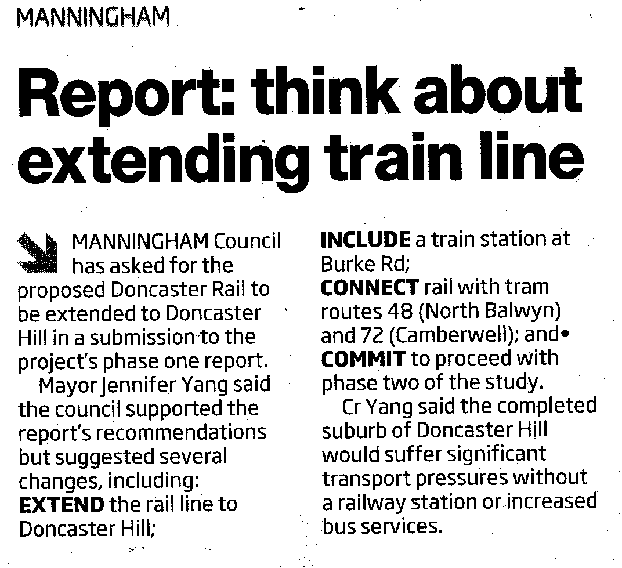5:09 AM Planning for chaos - June 2013. | |
You may have read this article in the Manningham Leader on page 7, June 26, 2013.
Here is some background to this story. A few years ago, the state government introduced plans to encourage population growth to occur within the existing suburbs of Melbourne. This was to ease the demand for new land and curb what was referred to at the time as 'urban sprawl'. The unrestrained growth of the suburbs alarmed conservationists some years back. It was the Labor state government under John Brumby, with Justin Madden as planning minister, that introduced the "Melbourne 2030 and Melbourne @ 5 Million" plan. This plan slated high density development along all train, tram and bus corridors. Under this plan hundreds of what many called inappropriate high density residences were built across the Melbourne metropolitan area. If you look at the areas slated for high density housing in Manningham, much of Doncaster Road, Manningham Road, Tram Road, etc. have been set aside for dramatic increases in the number of people living along them.
However there is a big problem with all this. The Manningham council commissioned a study in 2012 to look into the impact this increase in population would have on road traffic. They found that at 'full build out' under their current plans, traffic congestion on Doncaster Road during the afternoon peak hour rush, will be similar to the congestion experienced in inner city locations. That is, driving through Doncaster Hill during the evening peak hour rush will be similar to Burke Street in the city. It was calculated that to keep the traffic congestion to within reasonable limits, it was necessary to get a '30% mode shift to public transport'. That is, they found they need to get 30% of people out of their private cars and into public transport.
Buses and trams are not an answer to this traffic congestion problem. Buses are part of the road traffic and as congestion increases, their performance decreases, so they are not the answer. Extending trams to Doncaster cannot help to the extent they would like. Manningham has to get large numbers of people into and out of the city quickly and trams cannot do this.
There is great hope placed in the Doncaster Rail Line. Many see the Doncaster Rail project as providing the answer to Manningham's future traffic congestion problems. But as you know there are some problems with the Doncaster Rail.
The first problem is that the state government is not convinced it is needed right now. Instead they intend to widen the freeway and will reconsider the rail line at a later date. The second problem is that a station is not planned to be built at Doncaster Hill. As the plans stand now, the Doncaster Rail will be a very expensive railway line to a car park. And presumably once you get to this car park you either walk or take a bus up to Doncaster Hill. This is not a very attractive option. The council argues that the rail line must have a proper destination and not end at a car park. They argue that the rail line must go to Doncaster Hill to provide convenience and ease of use so that it will relieve future road traffic congestion in Doncaster Hill. And off course they are right. The third problem is that many think that the Doncaster Rail will not get anywhere near 30% of people out of their cars and onto the train. Section 9.1.3 of the "Doncaster Rail Study Phase One Recommendations Report" says: "All of our heavy rail options effectively transfer the bus patronage to the new rail line, however we expect negligible further forecast mode shift from car to train " The above needs to be read carefully. 'All the heavy rails options' considered in the report, have this one thing in common: people who currently travel by bus now will shift to using the train. And the number of people who switch from car to train will be negligible. In short, this report says the Doncaster Rail Line will not fix future traffic congestion problems in Doncaster. And there was a lot of traffic modelling, etc. done as part of the study and it was written by very capable and knowledgeable people. If we think the Doncaster Rail line will solve Doncaster's future traffic congestion problems and proceed on that assumption, the Doncaster Rail Line will be a very expensive mistake.
This is the situation we find ourselves in. The state government has put plans in motion to dramatically increase the population density in the urban areas of Melbourne. However, they overlooked some very important issues. The road and transport systems for one thing. And the Doncaster Rail line does not appear to be the answer we need. We need to go back to the drawing board and think a bit harder about this future problem.
16 July 2013. | |
| Views: 920 | Added by: Blogger | |
